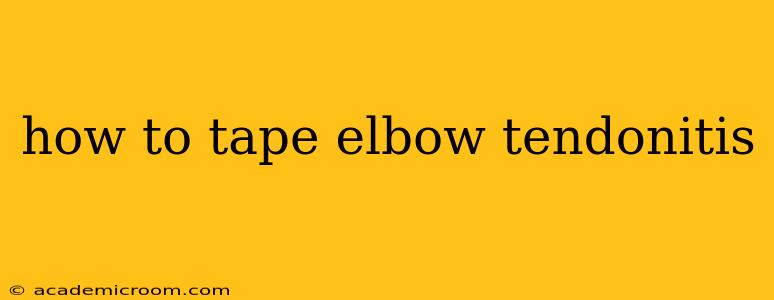Elbow tendonitis, encompassing conditions like golfer's elbow (medial epicondylitis) and tennis elbow (lateral epicondylitis), causes significant pain and discomfort. While medical advice is crucial, taping techniques can provide temporary pain relief and support, aiding in recovery and improving daily function. This guide explores effective taping methods for elbow tendonitis, addressing common questions and considerations.
What is the Best Tape for Elbow Tendonitis?
The ideal tape for elbow tendonitis offers both support and flexibility. Many athletes and physical therapists favor athletic tape, also known as kinesiology tape. Its elasticity allows for a wide range of motion while providing gentle support to the affected tendons. Other options include rigid tape (like zinc oxide tape) for more substantial support, particularly during activity. The choice depends on the severity of your condition and your activity level. Always consult a medical professional before starting any taping regimen.
How Do You Tape Your Elbow for Tendonitis?
The specific taping technique varies depending on the location of your pain (medial or lateral epicondyle) and the level of support needed. Here's a general approach:
1. Preparation: Cleanse the skin with rubbing alcohol or a similar solution to ensure the tape adheres properly. Shave any excess hair for better adhesion.
2. Anchor: Begin by anchoring the tape approximately 4-6 inches below the affected elbow joint, ensuring it's firmly attached.
3. Application (Lateral Epicondylitis – Tennis Elbow):
- Apply the tape with slight tension, running it across the lateral epicondyle (the bony bump on the outside of your elbow).
- Direct the tape slightly distally (towards your wrist) to alleviate tension on the affected tendons.
- Secure the tape firmly, stretching it approximately 25-50% of its resting length (depending on the type of tape used).
- Avoid applying the tape directly over the bony prominence, as this can cause irritation.
4. Application (Medial Epicondylitis – Golfer's Elbow):
- Similar to the above, anchor the tape below the elbow.
- Apply the tape across the medial epicondyle (bony bump on the inside of your elbow), directing it slightly distally.
- Stretch the tape appropriately, as with lateral epicondylitis.
- Again, avoid directly taping over the bony prominence.
5. Overlap: Overlap each strip of tape by about 50%, ensuring complete coverage and support.
6. Secure: Secure the end of each strip by anchoring it firmly to the skin.
7. Removal: Carefully remove the tape when necessary, gently peeling it in the direction of hair growth to minimize skin irritation.
How Long Should You Keep the Tape On?
The duration of tape application depends on individual tolerance and the type of tape used. Athletic tape can typically be worn for several days, while rigid tapes may be suitable for shorter periods. Remove the tape if you experience any skin irritation or increased pain. Generally, it's recommended to remove the tape at night to allow the skin to breathe.
Can Kinesiology Tape Help Elbow Tendonitis?
Kinesiology tape, with its elastic properties, aims to alleviate pain and provide support without restricting movement. It's believed to work by lifting the skin, improving blood flow and lymphatic drainage, and subtly influencing muscle and tendon activity. While its effectiveness for elbow tendonitis is not definitively proven in large-scale clinical trials, many individuals find it provides comfort and pain relief.
Does Taping Help Elbow Pain?
Taping techniques, especially those employing athletic tape, can offer temporary pain relief and support for elbow tendonitis. The support reduces stress on the affected tendons, and the slight elevation of the skin can improve circulation. However, taping should be considered a supplementary treatment, not a cure. It's essential to consult a healthcare professional for diagnosis and appropriate treatment.
What are Other Treatments for Elbow Tendonitis?
Beyond taping, various treatment options exist for elbow tendonitis, including:
- Rest and Ice: Avoid aggravating activities and apply ice packs to reduce inflammation.
- Over-the-Counter Pain Relief: Nonsteroidal anti-inflammatory drugs (NSAIDs) like ibuprofen can help manage pain and inflammation.
- Physical Therapy: A physical therapist can guide you through exercises to strengthen the muscles supporting your elbow joint and improve range of motion.
- Corticosteroid Injections: In severe cases, a doctor may recommend corticosteroid injections to reduce inflammation.
- Surgery: Surgery is rarely necessary but might be considered as a last resort for persistent, debilitating pain.
This information is for general knowledge and should not be considered medical advice. Always consult a healthcare professional for diagnosis and treatment of elbow tendonitis. They can determine the best course of action for your specific situation and advise on appropriate taping techniques if deemed suitable.
